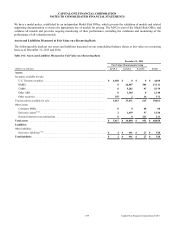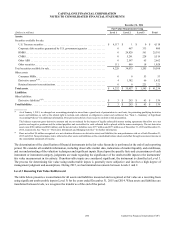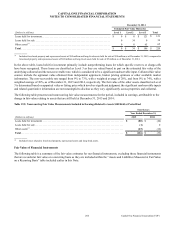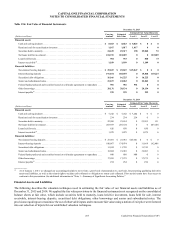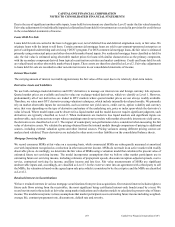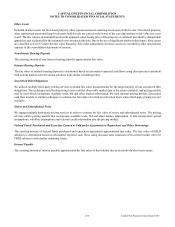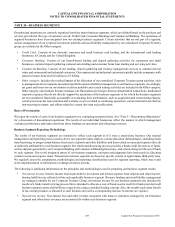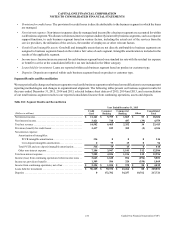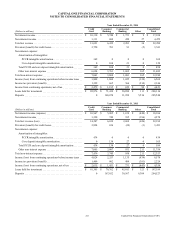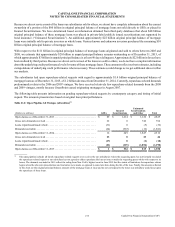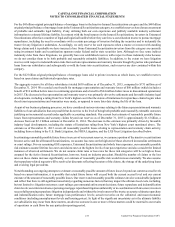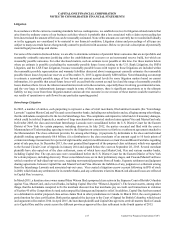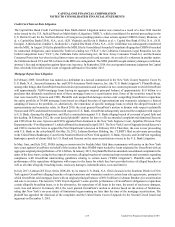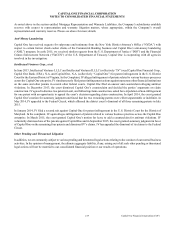Capital One 2015 Annual Report Download - page 228
Download and view the complete annual report
Please find page 228 of the 2015 Capital One annual report below. You can navigate through the pages in the report by either clicking on the pages listed below, or by using the keyword search tool below to find specific information within the annual report.
CAPITAL ONE FINANCIAL CORPORATION
NOTES TO CONSOLIDATED FINANCIAL STATEMENTS
209 Capital One Financial Corporation (COF)
NOTE 20—BUSINESS SEGMENTS
Our principal operations are currently organized into three major business segments, which are defined based on the products and
services provided or the type of customer served: Credit Card, Consumer Banking and Commercial Banking. The operations of
acquired businesses have been integrated into our existing business segments. Certain activities that are not part of a segment,
such as management of our corporate investment portfolio and asset/liability management by our centralized Corporate Treasury
group, are included in the Other category.
• Credit Card: Consists of our domestic consumer and small business card lending, and the international card lending
businesses in Canada and the United Kingdom.
• Consumer Banking: Consists of our branch-based lending and deposit gathering activities for consumers and small
businesses, national deposit gathering, national auto lending and consumer home loan lending and servicing activities.
• Commercial Banking: Consists of our lending, deposit gathering and treasury management services to commercial real
estate and commercial and industrial customers. Our commercial and industrial customers typically include companies with
annual revenues between $10 million to $1 billion.
• Other category: Includes the residual impact of the allocation of our centralized Corporate Treasury group activities, such
as management of our corporate investment portfolio and asset/liability management, to our business segments. Accordingly,
net gains and losses on our investment securities portfolio and certain trading activities are included in the Other category.
Other category also includes foreign exchange-rate fluctuations on foreign currency-denominated transactions; unallocated
corporate expenses that do not directly support the operations of the business segments or for which the business segments
are not considered financially accountable in evaluating their performance, such as acquisition and restructuring charges;
certain provisions for representation and warranty reserves related to continuing operations; certain material items that are
non-recurring in nature; and offsets related to certain line-item reclassifications.
Basis of Presentation
We report the results of each of our business segments on a continuing operations basis. See “Note 3—Discontinued Operations”
for a discussion of discontinued operations. The results of our individual businesses reflect the manner in which management
evaluates performance and makes decisions about funding our operations and allocating resources.
Business Segment Reporting Methodology
The results of our business segments are intended to reflect each segment as if it were a stand-alone business. Our internal
management and reporting process used to derive our segment results employs various allocation methodologies, including funds
transfer pricing, to assign certain balance sheet assets, deposits and other liabilities and their related revenue and expenses directly
or indirectly attributable to each business segment. Our funds transfer pricing process provides a funds credit for sources of funds,
such as deposits generated by our Consumer Banking and Commercial Banking businesses, and a funds charge for the use of funds
by each segment. Due to the integrated nature of our business segments, estimates and judgments have been made in allocating
certain revenue and expense items. Transactions between segments are based on specific criteria or approximate third-party rates.
We regularly assess the assumptions, methodologies and reporting classifications used for segment reporting, which may result
in the implementation of refinements or changes in future periods.
The following is additional information on the principles and methodologies used in preparing our business segment results.
• Net interest income: Interest income from loans held for investment and interest expense from deposits and other interest-
bearing liabilities are reflected within each applicable business segment. Because funding and asset/liability management
are managed centrally by our Corporate Treasury Group, net interest income for our business segments also includes the
results of a funds transfer pricing process that is intended to allocate a cost of funds used or credit for funds provided to all
business segment assets and liabilities, respectively, using a matched funding concept. Also, the taxable-equivalent benefit
of tax-exempt products is allocated to each business unit with a corresponding increase in income tax expense.
• Non-interest income: Non-interest fees and other revenue associated with loans or customers managed by each business
segment and other direct revenues are accounted for within each business segment.


